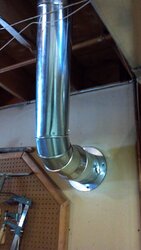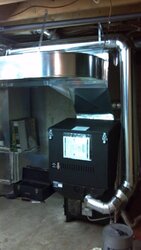For the past couple weeks I've been looking into how long an OAK can be... Unfortunately all I found on the site were questions of how long an OAK can be, nothing particularly on how long an oak can be...unlike sizing supply lines using calculations/etc...intakes/suctions are a bit different.
I will be installing a 55' run of 6" 26gauge insulated wrapped galv. ductwork with a few adj. elbows...coming in through my basement bulkhead ( through an old wood workshop vent that was previously installed)...I did simple energy audit myself and found quite a bit of cold outdoor air pulling through this duct collector exhaust fan....Might as well use it and try it out as an OAK after removing the squirrel cage fan and a butterfly damper. Its going from 7" through the wall to a 6" reducer, 55' of 6", then a 6" to 3" reducer to 2ft of 3" flex duct into the intake on the Harman (pf100).
I came to the conclusion of a 6" run just because I thought 4" was a little too restricting...if it doesnt work, I'll tap into the opposite side of my basement wall which is about 35' away and try an OAK in that location.
Wish me luck. Pics to follow and I'll let you know if there are any adverse effects from the install regarding performance and temps. Should be a lot more efficient in the basement due to no conditioned air being pulled from the space for combustion or outside air being pulled in though the cracks/envelopes/etc..Basement is appx 68-70degrees as is, house is 73-75.. 2-6bags/day thus far .....
My previous post on the install of my pf100 - since installed a bypass type humidifier, burned 5 tons, wife and family happy....huge savings from oil... Thanks guys!
I will be installing a 55' run of 6" 26gauge insulated wrapped galv. ductwork with a few adj. elbows...coming in through my basement bulkhead ( through an old wood workshop vent that was previously installed)...I did simple energy audit myself and found quite a bit of cold outdoor air pulling through this duct collector exhaust fan....Might as well use it and try it out as an OAK after removing the squirrel cage fan and a butterfly damper. Its going from 7" through the wall to a 6" reducer, 55' of 6", then a 6" to 3" reducer to 2ft of 3" flex duct into the intake on the Harman (pf100).
I came to the conclusion of a 6" run just because I thought 4" was a little too restricting...if it doesnt work, I'll tap into the opposite side of my basement wall which is about 35' away and try an OAK in that location.
Wish me luck. Pics to follow and I'll let you know if there are any adverse effects from the install regarding performance and temps. Should be a lot more efficient in the basement due to no conditioned air being pulled from the space for combustion or outside air being pulled in though the cracks/envelopes/etc..Basement is appx 68-70degrees as is, house is 73-75.. 2-6bags/day thus far .....
My previous post on the install of my pf100 - since installed a bypass type humidifier, burned 5 tons, wife and family happy....huge savings from oil... Thanks guys!



